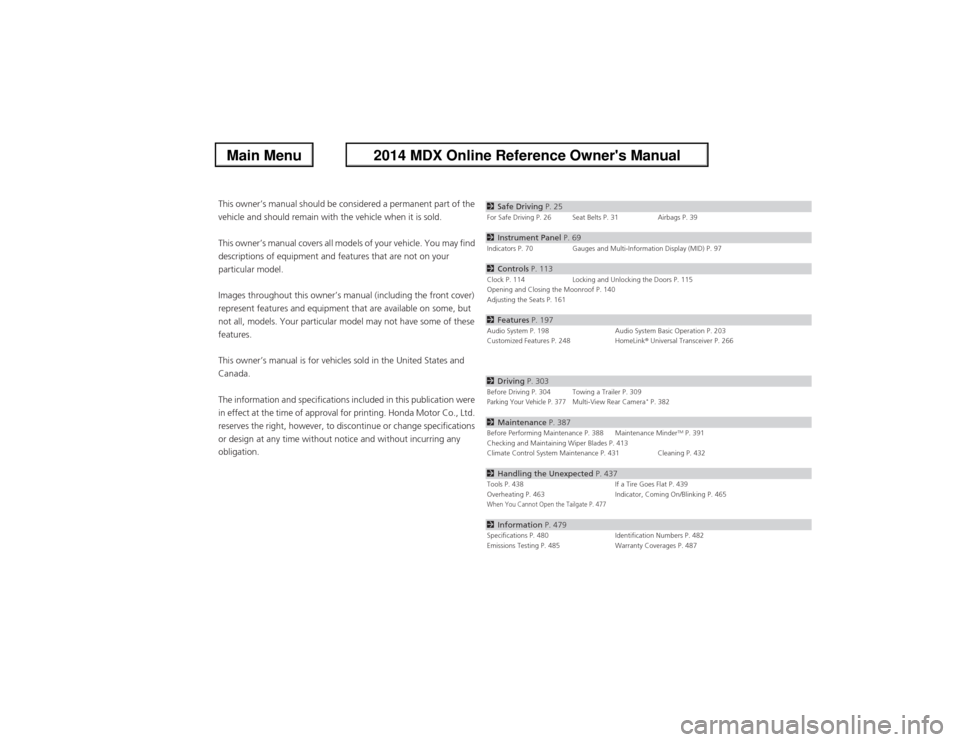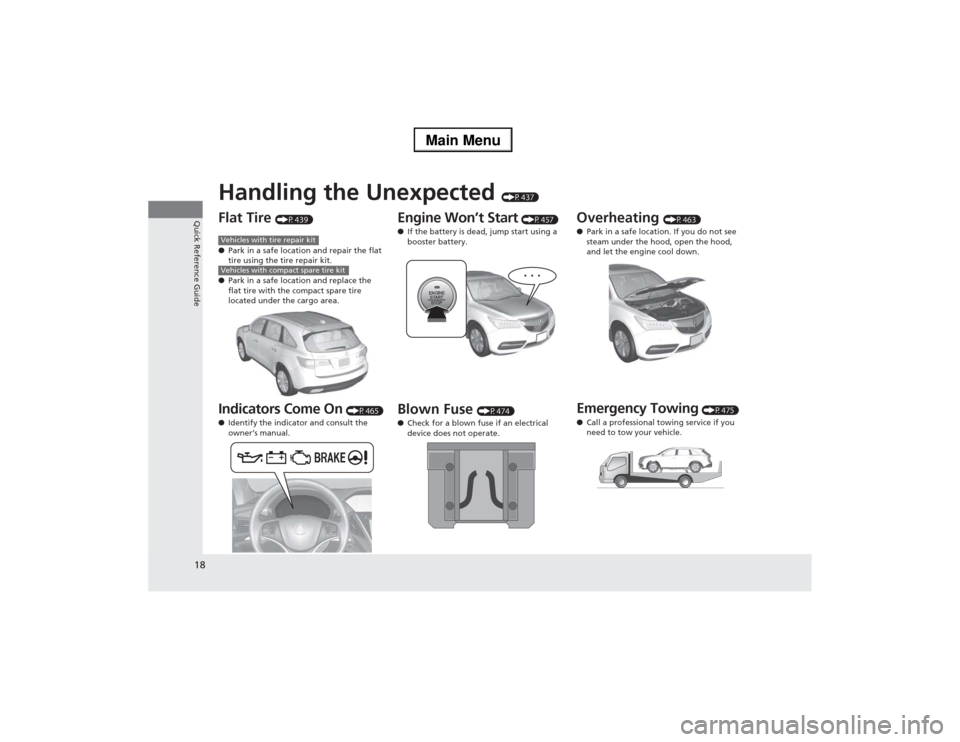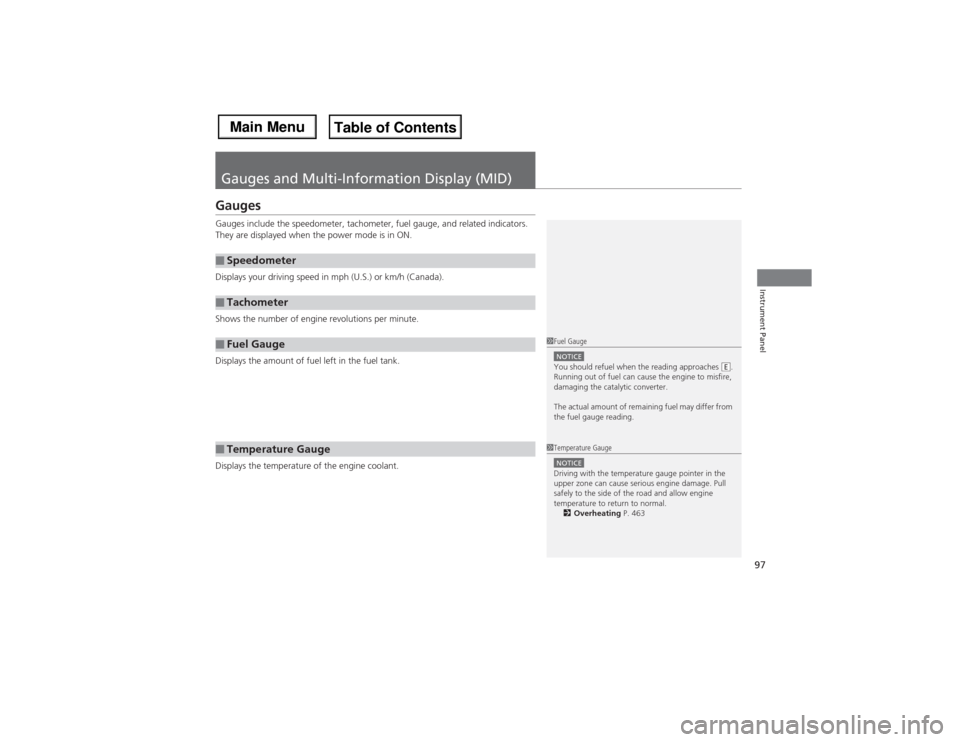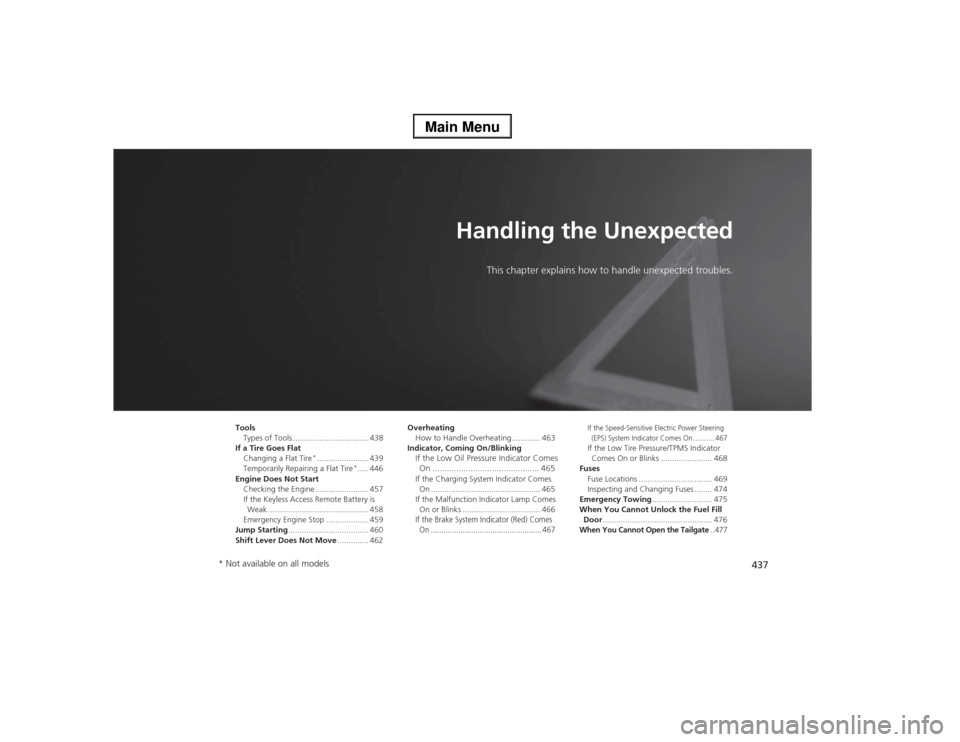heating Acura MDX 2014 Owner's Manual
[x] Cancel search | Manufacturer: ACURA, Model Year: 2014, Model line: MDX, Model: Acura MDX 2014Pages: 500, PDF Size: 11.72 MB
Page 1 of 500

ContentsThis owner’s manual should be considered a permanent part of the
vehicle and should remain with the vehicle when it is sold.
This owner’s manual covers all models of your vehicle. You may find
descriptions of equipment and features that are not on your
particular model.
Images throughout this owner’s manual (including the front cover)
represent features and equipment that are available on some, but
not all, models. Your particular model may not have some of these
features.
This owner’s manual is for vehicles sold in the United States and
Canada.
The information and specifications included in this publication were
in effect at the time of approval for printing. Honda Motor Co., Ltd.
reserves the right, however, to discontinue or change specifications
or design at any time without notice and without incurring any
obligation.
2Safe Driving P. 25For Safe Driving P. 26 Seat Belts P. 31 Airbags P. 392Instrument Panel P. 69Indicators P. 70 Gauges and Multi-Information Display (MID) P. 972Controls P. 113Clock P. 114 Locking and Unlocking the Doors P. 115
Opening and Closing the Moonroof P. 140
Adjusting the Seats P. 1612Features P. 197Audio System P. 198 Audio System Basic Operation P. 203
Customized Features P. 248 HomeLink® Universal Transceiver P. 2662Driving P. 303Before Driving P. 304 Towing a Trailer P. 309Parking Your Vehicle P. 377
Multi-View Rear Camera
* P. 382
2Maintenance P. 387Before Performing Maintenance P. 388 Maintenance Minder
TM P. 391
Checking and Maintaining Wiper Blades P. 413
Climate Control System Maintenance P. 431 Cleaning P. 432
2Handling the Unexpected P. 437Tools P. 438 If a Tire Goes Flat P. 439
Overheating P. 463 Indicator, Coming On/Blinking P. 465When You Cannot Open the Tailgate P. 4772Information P. 479Specifications P. 480 Identification Numbers P. 482
Emissions Testing P. 485 Warranty Coverages P. 487
Page 19 of 500

18Quick Reference Guide
Handling the Unexpected
(P437)
Flat Tire
(P439)
●Park in a safe location and repair the flat
tire using the tire repair kit.
●Park in a safe location and replace the
flat tire with the compact spare tire
located under the cargo area.
Indicators Come On
(P465)
●Identify the indicator and consult the
owner’s manual.
Vehicles with tire repair kitVehicles with compact spare tire kit
Engine Won’t Start
(P457)
●If the battery is dead, jump start using a
booster battery.
Blown Fuse
(P474)
●Check for a blown fuse if an electrical
device does not operate.
Overheating
(P463)
●Park in a safe location. If you do not see
steam under the hood, open the hood,
and let the engine cool down.
Emergency Towing
(P475)
●Call a professional towing service if you
need to tow your vehicle.
Page 87 of 500

86
uuIndicatorsuMulti-Information Display (MID) Warning and Information Messages
Instrument Panel
Message
Condition
Explanation
●Appears when the scheduled maintenance is due soon.●Consequently, Maintenance Due Now and
Maintenance Past Due follow.
2Maintenance Minder Messages on the Multi-
Information Display (MID) P. 392
●Appears when the engine coolant temperature gets
abnormally high.
2Overheating P. 463
●Appears when there is a problem with the power
tailgate system.
●Manually open or close the power tailgate.●Have your vehicle checked by a dealer.
U.S.Canada
Page 90 of 500

89
uuIndicatorsuMulti-Information Display (MID) Warning and Information Messages
Continued
Instrument Panel
Message
Condition
Explanation
●Appears when pressing the IDS button.
uPress again to change the next mode.
2Integrated Dynamics System (IDS) P. 333
●Appears if there is a problem with the radiator system.
●Drive slowly to prevent overheating and have your
vehicle checked by a dealer as soon as possible.
●Appears when there is a problem with the headlights.
●Appears while driving - The low beam headlights
may not be on. When conditions allow you to drive
safety, have your vehicle checked by a dealer as soon as
possible.
●Appears if there is a problem with the parking sensor
system
*.
●Check if the area around the sensor(s) is covered with
mud, ice, snow, etc. If the indicator(s) stays on or the
beeper does not stop even after you clean the area,
have the system checked by a dealer.
* Not available on all models
Page 98 of 500

97Instrument Panel
Gauges and Multi-Information Display (MID)GaugesGauges include the speedometer, tachometer, fuel gauge, and related indicators.
They are displayed when the power mode is in ON.
Displays your driving speed in mph (U.S.) or km/h (Canada).
Shows the number of engine revolutions per minute.
Displays the amount of fuel left in the fuel tank.
Displays the temperature of the engine coolant.■Speedometer■Tachometer■Fuel Gauge■Temperature Gauge
1Fuel GaugeNOTICEYou should refuel when the reading approaches .
Running out of fuel can cause the engine to misfire,
damaging the catalytic converter.
The actual amount of remaining fuel may differ from
the fuel gauge reading.
E
1Temperature GaugeNOTICEDriving with the temperature gauge pointer in the
upper zone can cause serious engine damage. Pull
safely to the side of the road and allow engine
temperature to return to normal.
2Overheating P. 463
Page 155 of 500

154
uuOperating the Switches Around the Steering WheeluDefogger/Heated Door Mirror
Controls
Defogger/Heated Door Mirror
Press the heated windshield button to deice
the windshield when the power mode is in
ON.
Press the rear defogger and heated door mirror button to defog the rear window
and mirrors when the power mode is in ON.
The rear defogger and heated door mirrors
automatically switch off after 10-30 minutes
depending on the outside temperature.
■Heated Windshield ButtonCanadian models
1Defogger/Heated Door Mirror
This system consumes a lot of power, so turn it off
when the window has been defogged or deiced.1Heated Windshield Button
When the outside temperature is below 4°C, the
heated windshield may automatically activate. The
system deactivates itself once the outside
temperature reaches 6°C.
■Rear Defogger/Heated Door Mirror Button
1Rear Defogger/Heated Door Mirror ButtonNOTICEWhen cleaning the inside of the rear window, be
careful not to damage the heating wires.
It is critical to wipe the window from side to side
along the defogger heating wires.
Page 317 of 500

316
uuTowing a TraileruTowing Preparation
Driving
■Hitches
Read the trailer manufacturer’s instructions, and select the appropriate draw bar for
the height of the trailer you will be towing.■Weight distribution hitches
Your vehicle is designed to tow without the need for a load distributing hitch. If you
wish to use one, please consult your trailer maker for proper installation and set-up.
Improper set-up could degrade the handling, stability, and braking performance of
your vehicle.■Safety chains
Always use safety chains when you tow a trailer. Leave enough slack to allow the
trailer to turn corners easily, but do not allow the chains to drag on the ground.■Sway control
This device can be used if your trailer tends to sway. Your trailer maker can tell you
what kind of sway control you need and how to install it. Improper installation could
degrade the handling and stability of your vehicle.■Automatic transmission cooler
Install an additional ATF (automatic transmission fluid) cooler to help prevent the
transmission from overheating, and damaging. You can get the additional ATF
cooler at a dealer.An additional ATF cooler is required to keep the transmission from overheating when
towing more than 3,500 lbs (1,588 kg). You can get the additional ATF cooler at a dealer.■Trailer mirrors
Many states, provinces and territories require special exterior mirrors when towing a
trailer. Install special mirrors whenever you cannot clearly see behind you, or if the
trailer creates a blind spot.4WD models
Page 418 of 500

417Maintenance
Checking and Maintaining TiresChecking TiresTo safely operate your vehicle, your tires must be of the proper type and size, in
good condition with adequate tread, and properly inflated.■Inflation guidelines
Properly inflated tires provide the best combination of handling, tread life, and comfort.
Refer to the driver’s doorjamb label or specification’s page for the specified pressure.
Underinflated tires wear unevenly, adversely affect handling and fuel economy, and
are more likely to fail from overheating.
Overinflated tires make your vehicle ride harshly, are more prone to road hazards,
and wear unevenly.
Every day before you drive, look at each of the tires. If one looks lower than the
others, check the pressure with a tire gauge.
At least once a month and before long trips, use a gauge to measure the pressure in
all tires, including the spare. Even tires in good condition can lose 1 to 2 psi (10 to
20 kPa, 0.1 to 0.2 kgf/cm
2) per month.
■Inspection guidelines
Every time you check inflation, also examine the tires and valve stems.
Look for:
•Bumps or bulges on the side or in the tread. Replace the tire if you find any cuts,
splits, or cracks in the side of the tire. Replace it if you see fabric or cord.
•Remove any foreign objects and inspect for air leaks.
•Uneven tread wear. Have a dealer check the wheel alignment.
•Excessive tread wear.2Wear Indicators P. 422
•Cracks or other damage around valve stem.
1Checking Tires
Measure the air pressure when tires are cold. This
means the vehicle has been parked for at least three
hours, or driven less than 1 mile (1.6 km). If
necessary, add or release air until the specified
pressure is reached.
If checked when hot, tire pressure can be as much as
4–6 psi (30–40 kPa, 0.3–0.4 kgf/cm
2) higher than if
checked when cold.
Have a dealer check the tires if you feel a consistent
vibration while driving. New tires and any that have
been removed and reinstalled should be properly
balanced.
3
WARNING
Using tires that are excessively worn or
improperly inflated can cause a crash in
which you can be seriously hurt or killed.
Follow all instructions in this owner’s
manual regarding tire inflation and
maintenance.
Page 438 of 500

437
Handling the Unexpected
This chapter explains how to handle unexpected troubles.
Tools
Types of Tools .................................. 438
If a Tire Goes Flat
Changing a Flat Tire
*....................... 439
Temporarily Repairing a Flat Tire
*..... 446
Engine Does Not Start
Checking the Engine ........................ 457
If the Keyless Access Remote Battery is
Weak ............................................. 458
Emergency Engine Stop ................... 459
Jump Starting.................................... 460
Shift Lever Does Not Move.............. 462Overheating
How to Handle Overheating............. 463
Indicator, Coming On/Blinking
If the Low Oil Pressure Indicator Comes
On ............................................. 465If the Charging System Indicator Comes
On ................................................. 465
If the Malfunction Indicator Lamp Comes
On or Blinks ................................... 466If the Brake System Indicator (Red) Comes
On .................................................... 467
If the Speed-Sensitive Electric Power Steering
(EPS) System Indicator Comes On ........... 467If the Low Tire Pressure/TPMS Indicator
Comes On or Blinks ....................... 468
Fuses
Fuse Locations ................................. 469
Inspecting and Changing Fuses ........ 474
Emergency Towing........................... 475
When You Cannot Unlock the Fuel Fill
Door................................................. 476When You Cannot Open the Tailgate
.. 477
* Not available on all models
Page 464 of 500

463
Continued
Handling the Unexpected
OverheatingHow to Handle OverheatingOverheating symptoms are as follows:
•The temperature gauge needle is at the mark or the engine suddenly loses
power.
•Steam or spray comes out of the engine compartment.■First thing to do
1.Immediately park the vehicle in a safe place.
2.Turn off all accessories and turn on the hazard warning lights.
uNo steam or spray present: Keep the engine running and open the hood.
uSteam or spray is present: Turn off the engine and wait until it subsides.
Then, open the hood.
1How to Handle OverheatingNOTICEContinuing to drive with the temperature gauge
needle at the mark may damage the engine.
3
WARNING
Steam and spray from an overheated
engine can seriously scald you.
Do not open the hood if steam is coming
out.
H
H